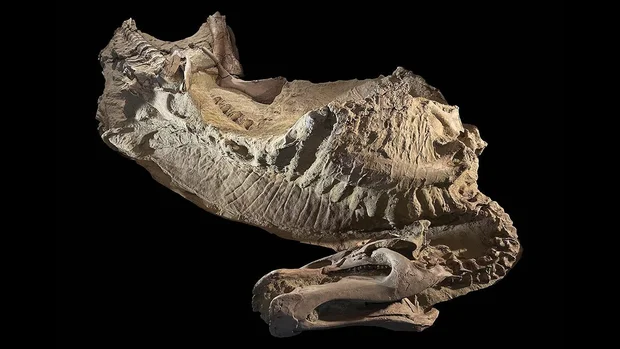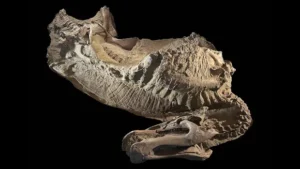🦖 How “Mummified” Fossils Helped University of Chicago Experts Recreate a Dinosaur’s Look and Lifestyle

A mummy of the juvenile duck-billed dinosaur Edmontosaurus annectens was preserved as a dried carcass some 66 million years ago in the badlands of Wyoming. Large areas of scaly, wrinkled skin and a tall, fleshy crest over its back were preserved in a thin layer of clay over its fossilized skeleton.
Chicago, IL — Scientists from the University of Chicago have unveiled a groundbreaking discovery that offers a stunningly detailed glimpse into what a certain duck-billed dinosaur looked like millions of years ago, all thanks to a set of exceptionally preserved “dinosaur mummies.”
In a new study published in Science, researchers describe how carcasses of the Edmontosaurus annectens, a plant-eating dinosaur that lived around 66 million years ago, were naturally transformed into “mummies.” These rare fossils preserved intricate details of the dinosaur’s scales, hooves, and skin patterns, providing scientists with clues about its real-life appearance.
A Thin Clay Film That Preserved History
The preservation process, called clay templating, occurred when the dinosaur’s skin and soft tissues were sealed beneath an ultra-thin layer of clay, no thicker than 0.01 inch. Over time, this natural clay mask created a perfect negative imprint of the dinosaur’s body, even as the organic material decayed away.
These “mummified” fossils were first discovered in the early 1900s in east-central Wyoming. Decades later, University of Chicago paleontologist Dr. Paul Sereno and his team revisited the same region, where they mapped out a so-called “mummy zone” along the southern edge of the Hell Creek and Lance Formations near the Cheyenne River.
There, the team unearthed two new Edmontosaurus specimens — one an older juvenile and the other a younger adult, both showing extensive preserved skin impressions covered by the delicate clay film.
“This isn’t like Egyptian mummies,” Sereno explained. “No soft tissue remains — just a mask, a clay template so thin you could blow it away. It was a fluke event of preservation.”
Science Meets Art: Rebuilding a Dinosaur’s Image
Using advanced imaging techniques — including hospital-grade CT scans, micro-CT, and X-ray spectroscopy — the team analyzed how the clay layer had formed and hardened. Their findings revealed that the dinosaurs’ bodies were likely exposed to sunlight before being suddenly buried by a flash flood.
A thin biofilm formed on the carcasses, attracting clay particles that electrostatically adhered to the surface. The clay then hardened with microbial help, preserving the dinosaur’s outer form in astonishing detail.
Over millions of years, the skeleton fossilized beneath the clay, leaving behind a three-dimensional mold that scientists could study today.
What the “Mummies” Revealed
The preserved impressions allowed researchers to reconstruct the Edmontosaurus with unprecedented accuracy. They discovered that the dinosaur featured:
- A fleshy crest running from its neck down to its tail.
- A row of spikes, each aligned with a vertebra.
- Small scales, surprisingly fine for a creature that could grow up to 40 feet long.
- And most remarkably — flat-bottomed hooves, similar to those of a horse.
This discovery officially makes Edmontosaurus the first known hooved reptile — and the earliest land vertebrate known to have hooves, according to Sereno.
Bringing the Ancient World to Life
To visualize their findings, Sereno’s team collaborated with digital paleoartists to recreate lifelike images of Edmontosaurus trudging through prehistoric mud — offering a rare, scientifically accurate look at a dinosaur in motion.
“It’s worth assembling a dream team to create science that connects with the public,” Sereno said. “We’ve never before been able to visualize a large prehistoric reptile with such realism — and just in time for Halloween.”
Sereno, one of the world’s most recognized dinosaur hunters, called this study “perhaps the single best paper I’ve ever released.”
Among the co-authors is Tyler Keillor, the University of Chicago’s fossil lab manager and a renowned paleoartist, previously featured by CBS Chicago’s Harry Porterfield as “Someone You Should Know.”
- 🦖 How “Mummified” Fossils Helped University of Chicago Experts Recreate a Dinosaur’s Look and Lifestyle
- RFK Jr Sparks Outrage After Urging Americans to Eat More Saturated Fats, Health Experts Sound Alarm
- Staffing Crisis Hits US Hospitals as Trump’s Visa Restrictions Stall International Medical Residents
- A Mother’s Kidney And A Daughter’s New Life: Cameron’s Miraculous Recovery
- Harvard Doctor Reveals What Really Happens When You Quit Sugar for 30 Days








